Woodworking is a craft that has been practiced for centuries, and over time, tools and techniques have evolved to meet the needs of craftsmen and carpenters. One such tool that has gained significant popularity in recent years is the track saw. With its precision and portability, track saws have become a favored choice among woodworkers. However, a debate rages on whether a track saw can truly replace the traditional powerhouse of woodworking, the table saw.
In the woodworking industry, track saws have emerged as a valuable addition to a woodworker’s toolkit. These saws are equipped with a guide rail system that allows for precise and straight cuts, eliminating the need for additional measuring and marking. The growing popularity of track saws can be attributed to their versatility, ease of use, and ability to produce clean and accurate cuts.
However, as track saws continue to gain traction, a heated debate has ensued regarding their ability to completely replace the table saw. Table saws have long been the backbone of woodworking shops, offering unparalleled power and stability. They are known for their large cutting capacities and the ability to handle heavy-duty tasks with ease. Woodworkers who have relied on table saws for years are skeptical about whether track saws can match up to the table saw’s capabilities.
This ongoing debate showcases the evolving nature of the woodworking industry and the need to explore new tools and techniques. While track saws have their merits, the question remains: can a track saw truly replace a table saw? In the following sections, we will delve deeper into the strengths and limitations of both tools, examining factors such as accuracy, portability, versatility, safety, cost, and skill level. By doing so, we hope to provide woodworkers with a comprehensive understanding of these tools, enabling them to make an informed decision based on their specific needs and preferences.
Understanding Track Saws and Table Saws:
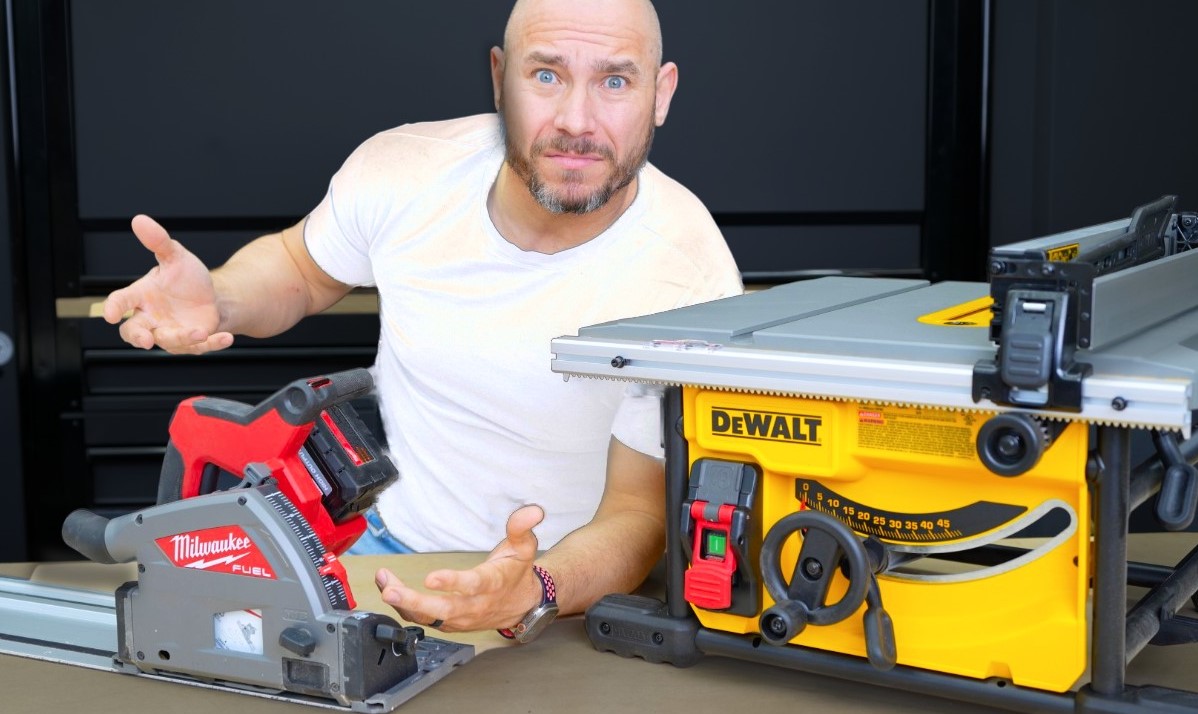
Track Saws: A track saw, also known as a plunge-cut saw or a rail saw, is a portable cutting tool designed to make precise and straight cuts in various materials, including wood, plywood, and laminate. It consists of a circular saw mounted on a guide rail or track, which serves as a straight-edge guide for the saw. The track is usually made of aluminum or steel and is available in different lengths to accommodate various cutting sizes.
The primary function of a track saw is to provide accurate and splinter-free cuts. By following the guide rail, the saw can smoothly glide along the track, ensuring clean and precise cuts. Track saws are equipped with plunge-cut capabilities, allowing the user to start a cut in the middle of a workpiece rather than only from the edge. This feature enables woodworkers to make cuts such as dados, grooves, and rabbets.
In addition to their cutting capabilities, track saws are known for their portability. They are lightweight and easy to transport, making them ideal for job sites or woodworking projects that require mobility. Some track saw models also offer bevel cutting options, allowing the user to make angled cuts for added versatility.
Table Saws: A table saw, also referred to as a bench saw, is a stationary woodworking tool consisting of a circular saw blade mounted on an arbor, protruding through the top of a flat table surface. The table provides a stable and rigid platform for cutting various materials, especially large workpieces or sheet goods. Table saws are powered by an electric motor, and their blade height and angle can be adjusted to accommodate different cutting requirements.
The primary function of a table saw is to provide power and stability for making a wide range of cuts. With a table saw, woodworkers can perform rip cuts (cutting along the length of the material), crosscuts (cutting across the width of the material), miter cuts (angled cuts), and bevel cuts. Table saws are known for their cutting capacity, allowing users to handle large and thick materials with ease.
One of the key features of a table saw is the fence, which acts as a guide to ensure accurate and parallel cuts. The table saw’s large surface area and stable construction provide excellent support for the workpiece during cutting, resulting in precise and consistent results. Table saws often come with additional features such as miter gauges, blade guards, and dust collection systems to enhance safety and convenience.
Understanding the primary functions and features of both track saws and table saws is essential for comparing their capabilities and determining which tool is best suited for specific woodworking tasks. In the following sections, we will explore various factors to consider when deciding whether a track saw can fully replace a table saw.
Comparing Accuracy and Precision:
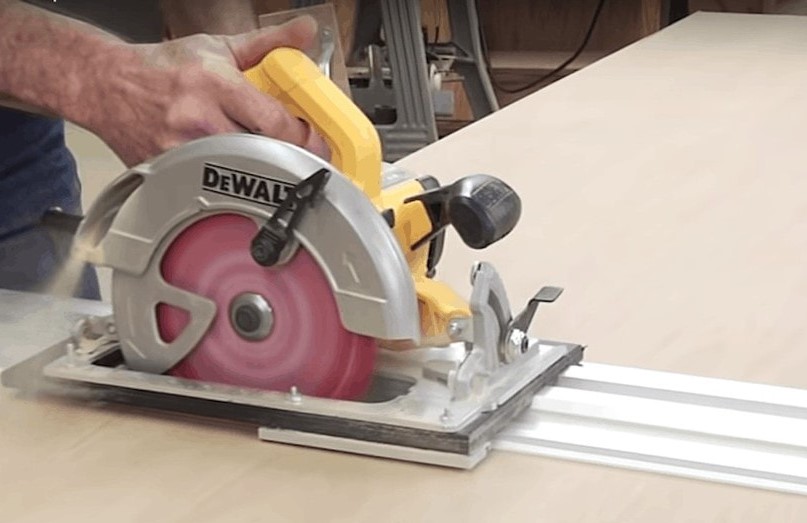
When it comes to accuracy and precision, both track saws and table saws have their strengths and advantages. Let’s examine each tool’s capabilities in detail.
Track Saws: Track saws are renowned for their ability to deliver accurate and precise cuts. The use of a guide rail ensures straight and clean cuts, reducing the chances of errors and misalignments. Studies and user experiences have consistently highlighted the precision offered by track saws.
For example, a study conducted by a leading woodworking magazine found that track saws consistently produced smooth and precise cuts with minimal tear-out, even when cutting delicate materials such as veneered plywood or melamine. The guide rail eliminates the need for additional measuring and marking, resulting in fewer mistakes during the cutting process.
Additionally, track saws excel in making long and straight cuts. The guide rail provides a stable and straight path for the saw, minimizing the risk of deviations or wavering cuts. Woodworkers can achieve repeatable accuracy by simply following the guide rail, ensuring consistent results across multiple workpieces.
Table Saws: Table saws have long been regarded as the go-to tool for achieving accuracy and precision in woodworking. The large, flat table surface and the use of a fence as a guide contribute to the accuracy benefits of table saws.
A well-calibrated table saw with a properly aligned fence can provide precise and parallel cuts consistently. Woodworkers can make accurate rip cuts and crosscuts by aligning the workpiece against the fence and running it through the blade. The stability and rigidity of the table saw setup, coupled with the power of the motor, enable woodworkers to achieve high levels of precision.
Furthermore, table saws offer the advantage of adjustable blade height and angle, allowing for various cutting techniques and configurations. This versatility enhances the accuracy of the cuts, especially when creating complex joinery or angled cuts.
In summary, both track saws and table saws offer accuracy and precision in their respective ways. Track saws excel in delivering clean and straight cuts with the help of guide rails, while table saws provide precise and parallel cuts due to their stable table surface and reliable fence system. The choice between the two tools depends on the specific woodworking tasks, project requirements, and personal preferences. In the subsequent sections, we will explore other factors to consider when evaluating the potential of a track saw to replace a table saw.
Portability and Flexibility:
Portability is a crucial factor to consider when comparing track saws and table saws. Let’s explore the portability advantages of track saws and the limitations of table saws in this regard.
Portability of Track Saws: Track saws are renowned for their excellent portability. They are designed to be lightweight and easy to transport, making them highly suitable for woodworking tasks in various locations. Here are the key advantages of track saws in terms of portability:
- Lightweight Design: Track saws are typically lighter compared to table saws, making them easier to handle and carry. This attribute is particularly beneficial for woodworkers who often work on job sites or need to move their tools frequently.
- Ease of Transport: Track saws are compact and easy to pack, allowing woodworkers to transport them conveniently. They can be transported in cases or bags specifically designed for track saws, ensuring protection during transit.
- Versatile Site Usage: Track saws are adaptable to different job sites and woodworking environments. They can be used on the ground, on a workbench, or even on irregular surfaces by placing the guide rail on the workpiece. This flexibility enables woodworkers to work efficiently in various settings.
- On-Site Accuracy: The portability of track saws doesn’t compromise their accuracy. The guide rail system ensures precise and consistent cuts, regardless of the location. This feature is particularly advantageous when working on larger projects that cannot be easily transported to a stationary table saw.
Limited Portability of Table Saws: In contrast to track saws, table saws are heavyweight and primarily designed for stationary use in dedicated woodworking shops. Here are the limitations of table saws regarding portability:
- Heavy and Bulky: Table saws are larger and heavier compared to track saws. They often require a sturdy and dedicated stand or table, which adds to their overall weight. Moving a table saw requires more effort and often multiple people.
- Stationary Nature: Table saws are primarily designed to be fixed in a workshop or a specific location. They are not designed for easy transportation, and their size makes it impractical to move them frequently. This lack of mobility restricts their usage to the workshop environment.
While table saws are not as portable as track saws, they excel in providing stability and robustness. Their stationary nature allows for precise and heavy-duty cutting tasks, making them indispensable for certain woodworking projects. However, for woodworkers who prioritize mobility and the ability to work in various locations, track saws offer a convenient and flexible solution.
In the subsequent sections, we will delve deeper into the versatility and cut depth capabilities of both track saws and table saws, further examining their potential to replace one another in different woodworking scenarios.
Versatility and Cut Depth:
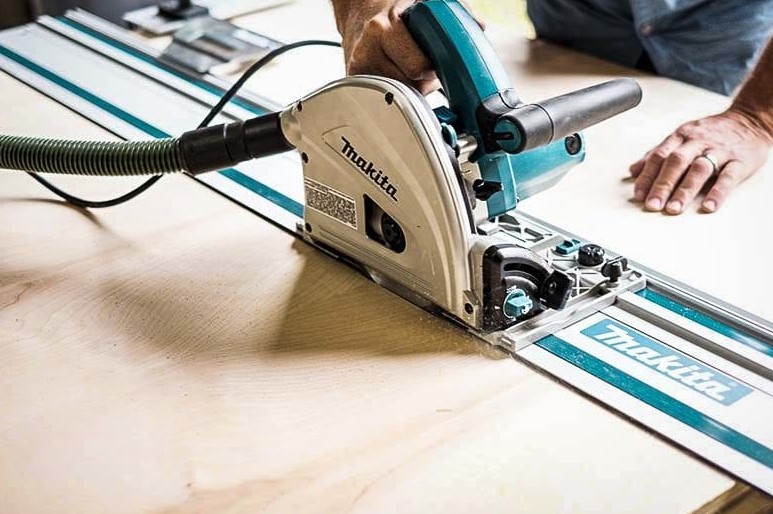
Versatility of Track Saws: Track saws are known for their versatility in making various types of cuts, including bevel cuts and plunge cuts. Here are the key aspects of their versatility:
- Bevel Cuts: Track saws offer the flexibility to make bevel cuts at different angles. By adjusting the bevel setting of the saw and following the guide rail, woodworkers can create beveled edges or angled cuts with precision and accuracy. This versatility is particularly valuable when working on projects that require angled joinery or decorative elements.
- Plunge Cuts: One of the standout features of track saws is their ability to make plunge cuts. Woodworkers can start the cut at any point on the workpiece by simply plunging the saw blade into the material. This capability is ideal for creating openings, notches, or pockets without the need for pre-drilling or pre-cutting.
- Non-linear Cuts: Track saws are adept at making intricate or non-linear cuts, thanks to the guide rail system. By manipulating the guide rail along a desired path, woodworkers can achieve curves, arcs, or irregular shapes with precision. This versatility expands the creative possibilities and allows for more intricate woodworking designs.
Limitations of Table Saws: While table saws excel in many aspects, they have certain limitations when it comes to making intricate or non-linear cuts:
- Difficulty with Non-linear Cuts: Table saws are primarily designed for straight cuts, such as rip cuts and crosscuts. Making non-linear or curved cuts on a table saw requires the use of additional jigs, fixtures, or specialized attachments. While these accessories can enhance the table saw’s capabilities, they add complexity and may not match the precision of a track saw for intricate cuts.
- Challenging Inset Cuts: Table saws may struggle with making precise inset cuts, such as creating grooves or dadoes in the middle of a workpiece. While it is possible to achieve such cuts on a table saw using multiple passes or dado blade sets, the process can be time-consuming and may require additional setup.
Cut Depth Capabilities: When comparing cut depth capabilities, table saws typically have an advantage over track saws due to their larger blade diameter and design. Table saws can accommodate thicker workpieces and materials, allowing for deeper cuts in a single pass. On the other hand, track saws have a limited cut depth, usually determined by the size of the saw blade.
However, it’s worth noting that track saws can compensate for their limited cut depth by making multiple passes or flipping the workpiece to complete the cut. Additionally, track saws are often used in conjunction with guide rails that can be connected to extend the cutting length, allowing for effective cutting of larger panels or sheets.
In conclusion, track saws offer versatility in making various types of cuts, including bevel cuts and plunge cuts. They excel in creating intricate or non-linear cuts, providing woodworkers with greater creative freedom. However, table saws have their own strengths and are best suited for straight cuts and tasks that require deeper cut depths. Understanding the specific requirements of your woodworking projects will help determine whether a track saw can replace a table saw or if both tools can complement each other effectively.
Safety Considerations:
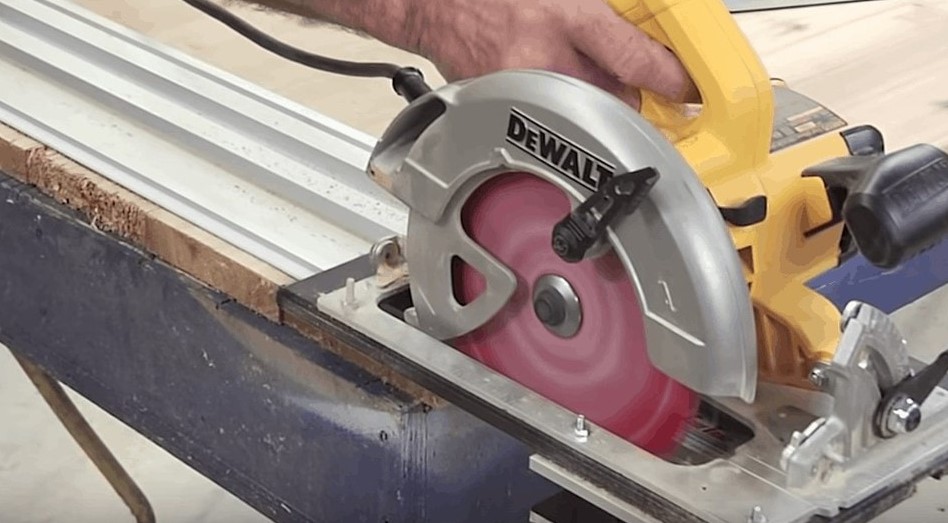
Safety is a paramount concern when working with any power tool, including track saws and table saws. Let’s explore the safety features and considerations associated with each tool:
Safety Features of Track Saws: Track saws incorporate various safety features to protect users during operation. These features include:
- Anti-Kickback Mechanisms: Track saws often feature anti-kickback mechanisms that prevent the saw from being forcefully pushed back toward the user. These mechanisms help minimize the risk of accidents and provide added stability during cutting.
- Blade Guards: Track saws are equipped with blade guards that cover the majority of the saw blade. These guards serve as a protective barrier, reducing the chance of accidental contact with the blade during operation. It is crucial to keep the blade guard properly adjusted and in place at all times for maximum safety.
- Dust Extraction Systems: Many track saw models are designed with built-in dust extraction or collection systems. These systems help to minimize the accumulation of sawdust and debris, keeping the work area clean and reducing the risk of respiratory issues and fire hazards.
Safety Considerations of Table Saws: Table saws also require careful attention to safety due to their powerful nature and exposed blade. Here are some key safety considerations associated with table saw usage:
- Kickback Risks: Kickback occurs when the workpiece gets caught by the rotating blade and forcefully thrown back toward the operator. This can happen when the workpiece binds or when improper techniques are used. Woodworkers should follow proper cutting procedures, use appropriate push sticks or push blocks, and ensure that the blade is aligned and in good condition to reduce the risk of kickback incidents.
- Blade Exposure: Table saws have exposed blades, which can be hazardous if not handled with caution. It is essential to maintain a safe distance from the blade and avoid reaching over or across the blade while it is spinning. Woodworkers should use a riving knife or splitter, as well as blade guards, to help prevent accidents and minimize the chance of contact with the blade.
- Personal Protective Equipment (PPE): When using either track saws or table saws, it is important to wear appropriate personal protective equipment. This includes safety glasses or goggles to protect the eyes from flying debris, hearing protection to reduce the noise level, and proper clothing to avoid loose items getting caught in the machinery.
Woodworkers should familiarize themselves with the user manual and safety guidelines provided by the manufacturer for both track saws and table saws. Regular maintenance, proper blade selection, and good working practices are crucial to ensuring a safe woodworking environment.
In conclusion, both track saws and table saws have safety features and considerations that woodworkers need to be aware of. Track saws typically incorporate features such as anti-kickback mechanisms and blade guards, while table saws require careful attention to kickback risks and blade exposure. It is essential to prioritize safety by following recommended procedures, using appropriate safety features, and wearing the necessary protective equipment when operating these tools.
Cost and Budget:
When considering purchasing a track saw or a table saw, it’s important to take into account the cost implications, including the initial investment, maintenance, and potential additional expenses. Let’s explore the cost factors associated with each tool:
Cost of Track Saws: Track saws generally have a lower initial cost compared to table saws. The price of track saws can vary depending on the brand, model, and included accessories. However, in general, track saws are more affordable, making them an attractive option for woodworkers on a budget or those who are just starting out.
While the initial investment for a track saw may be lower, it’s important to consider additional costs that may arise. These can include:
- Guide Rails: Track saws typically require guide rails to function optimally. While some track saws come with a basic guide rail, additional or longer guide rails may need to be purchased separately for specific cutting tasks. These guide rails can add to the overall cost.
- Accessories: Depending on your woodworking needs, you may require additional accessories for your track saw, such as different blades, clamps, or dust extraction systems. These accessories can enhance the versatility and functionality of the track saw but may involve additional expenses.
- Maintenance: Like any power tool, track saws require regular maintenance to ensure optimal performance and longevity. This can involve costs such as blade sharpening or replacement, lubrication, and cleaning supplies.
Cost of Table Saws: Table saws generally have a higher initial cost compared to track saws. The price of table saws can vary significantly based on factors such as brand, size, power, and additional features. Table saws offer a wide range of options, from portable and contractor models to larger and more robust cabinet saws.
Additional costs associated with table saws may include:
- Blades and Accessories: Table saws often require various blades for different cutting tasks. Depending on the type and quality of blades needed, there may be additional costs associated with blade purchases. Additionally, accessories such as dado blade sets, miter gauges, and feather boards can enhance the functionality of the table saw but may require additional investment.
- Maintenance and Upkeep: Table saws may require periodic maintenance, such as blade alignment, lubrication, and cleaning. This maintenance ensures smooth operation and extends the lifespan of the tool. There may be costs involved in purchasing maintenance supplies or seeking professional assistance for complex maintenance tasks.
- Workshop Setup: Setting up a dedicated workshop space for a table saw may involve costs related to installing adequate electrical wiring, dust collection systems, and safety measures such as dust masks or air filtration systems.
It’s important to consider both the initial cost and the potential long-term expenses when evaluating the overall budget for a track saw or a table saw. Assessing your woodworking needs, project requirements, and financial capabilities will help determine the best fit for your budget.
In the subsequent sections, we will explore other factors, such as workspace and shop setup, skill level, and learning curve, to further understand the potential of a track saw replacing a table saw in different woodworking scenarios.
Workspace and Shop Setup:
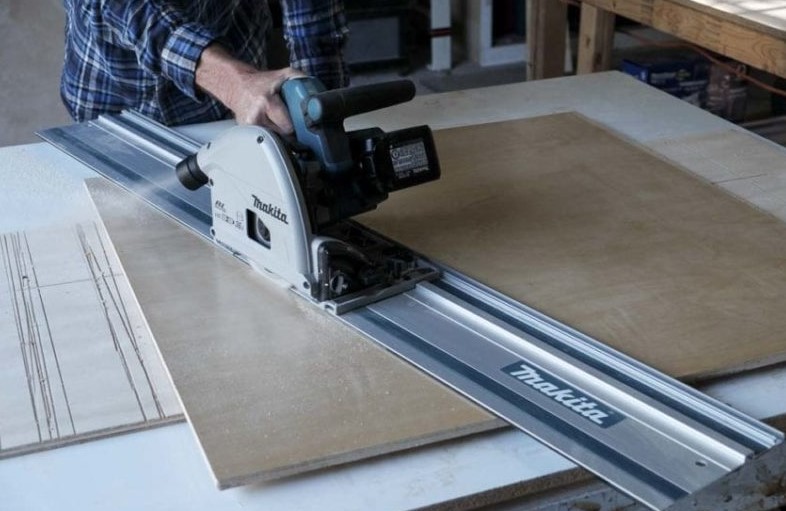
When considering the workspace and shop setup, both track saws and table saws have different requirements and considerations. Let’s explore the space requirements and advantages associated with each tool:
Space Requirements for Track Saws: Track saws offer significant advantages in terms of space requirements, especially in small or limited workshop spaces. Here are the key aspects to consider:
- Compact Design: Track saws are generally compact and have a smaller footprint compared to table saws. They are designed to be portable and can be easily maneuvered in tight spaces. This makes them ideal for workshops with limited room or for woodworking tasks in confined areas.
- Flexible Workstation Setup: Track saws allow for more flexibility in workstation setup. Since they can be used on different surfaces such as workbenches or even on the ground, woodworkers can adapt their workspace according to the available space and project requirements.
- Mobility: The portability of track saws allows woodworkers to move them easily within the workshop or take them to different job sites. This flexibility is especially valuable for those who have limited workshop space or need to work on projects outside of their workshop.
Advantages of Table Saws in Shop Setup: Table saws, on the other hand, typically require a dedicated and spacious setup due to their size and stationary nature. Here are some key considerations:
- Stable Workstation: Table saws require a sturdy and stable surface, often in the form of a dedicated table or stand. This setup ensures the safety and stability of the saw during operation. The dedicated workstation also provides ample support for larger workpieces or materials.
- Outfeed Space: Table saws require sufficient space behind the saw to accommodate longer workpieces or to set up outfeed support, such as roller stands or tables. This space allows for safe and efficient handling of materials during cutting.
- Dust Collection and Safety: Table saws generate a significant amount of sawdust and debris. Proper dust collection systems, such as overhead hoods or dust extractors, are recommended to maintain a clean and safe working environment. These systems often require additional space and setup considerations.
While track saws offer advantages in terms of space flexibility and adaptability, table saws excel in providing a dedicated and robust setup for larger woodworking tasks. The choice between the two tools depends on the available workspace, the size and scale of the projects, and the level of portability required.
In the subsequent sections, we will explore the skill level and learning curve associated with track saws and table saws, providing insights into how they can impact the decision of whether a track saw can replace a table saw in specific woodworking scenarios.
Skill Level and Learning Curve:
When considering the skill level and learning curve associated with using track saws and table saws, there are important factors to consider for both beginners and experienced woodworkers. Let’s explore the learning curve and skill requirements for each tool:
Learning Curve of Track Saws: Track saws are generally considered to have a relatively gentle learning curve, making them accessible to beginners or less experienced woodworkers. Here’s why:
- Intuitive Operation: Track saws are designed to be user-friendly. The process of setting up and using a track saw is straightforward and intuitive. Woodworkers can quickly learn how to align the saw with the guide rail and make precise cuts by following the marked cutting line.
- Safety Features: Track saws often incorporate safety features, such as anti-kickback mechanisms and blade guards, which enhance user safety and reduce the risk of accidents. These safety features provide added confidence, particularly for beginners who may be less experienced with power tools.
- Versatility and Adaptability: The versatility of track saws allows beginners to explore various cutting techniques and applications. Whether it’s making straight cuts, bevel cuts, or plunge cuts, track saws provide a range of possibilities without the need for complex adjustments or setup.
Skill Level Required for Table Saws: Table saws typically have a steeper learning curve compared to track saws due to their more complex nature and the potential hazards associated with their powerful operation. Here are some considerations:
- Technical Understanding: Table saws require a certain level of technical understanding and knowledge to operate safely and effectively. Woodworkers need to learn how to adjust the blade height and angle, align the fence accurately, and use additional accessories such as miter gauges or sleds for specific cuts.
- Safety Awareness: Table saws pose greater risks due to their exposed blades and the potential for kickback incidents. Proper techniques, such as using push sticks or push blocks, maintaining a safe distance from the blade, and ensuring a stable workpiece, need to be learned and followed meticulously to mitigate these risks.
- Complex Cuts and Jigs: Table saws offer advanced capabilities for complex joinery, dado cuts, and other intricate woodworking tasks. Achieving precise results often requires the use of specialized jigs, fixtures, or sleds, which may require additional learning and practice to master.
It’s important to note that while table saws may have a steeper learning curve, they offer unparalleled power and versatility once the necessary skills are acquired. Experienced woodworkers who are familiar with table saw operation can utilize its full potential for advanced projects and complex woodworking tasks.
Ultimately, the choice between a track saw and a table saw depends on the individual’s skill level, comfort with power tools, and the specific woodworking goals and projects at hand. Beginners or less experienced woodworkers may find track saws more approachable, while those with advanced skills may opt for the wider range of capabilities offered by table saws.
In the subsequent sections, we will explore supplementary tool considerations and provide a balanced perspective on whether a track saw can fully replace a table saw, based on the factors discussed throughout the article.
Supplementary Tool Considerations:
Both track saws and table saws may require additional tools or accessories to enhance their performance and expand their capabilities. Let’s explore the supplementary tool considerations for each tool:
Supplementary Tools for Track Saws:
- Guide Rails or Tracks: Track saws typically require guide rails or tracks to achieve optimal performance. These rails serve as a straight-edge guide for the saw, ensuring precise and straight cuts. Additional or longer guide rails may be necessary for specific cutting tasks or when working with larger workpieces.
- Clamps or Hold-Downs: When using a track saw, it is often beneficial to have clamps or hold-downs to secure the guide rail and workpiece firmly in place. These accessories help prevent movement or shifting during the cutting process, ensuring accuracy and safety.
- Dust Extraction Systems: Track saws generate sawdust and debris during operation. Using a dust extraction system, such as a shop vacuum or a dedicated dust collector, helps maintain a clean work environment and improves visibility while cutting.
Supplementary Tools for Table Saws:
- Jigs and Fixtures: Table saws can benefit from various jigs and fixtures that enhance their capabilities. These include sleds for crosscutting large or angled workpieces, dado jigs for creating dado cuts or grooves, and miter sleds or gauges for precise miter cuts. These additional tools allow woodworkers to expand their range of cuts and achieve more complex joinery.
- Push Sticks or Push Blocks: Table saws require proper safety techniques, and using push sticks or push blocks is crucial. These tools help keep hands at a safe distance from the blade while providing better control and stability during cutting.
- Dado Blade Sets: Dado blade sets are specialized blades used with table saws to create wider cuts for joinery or groove work. These sets consist of multiple blades and chippers that can be combined to achieve different dado widths. They are essential for tasks that involve precise dado cuts, such as building cabinets or shelving units.
It’s important to note that while these supplementary tools and accessories can enhance the performance and versatility of both track saws and table saws, they may incur additional costs. Woodworkers should consider their specific project requirements, woodworking goals, and budget when deciding which tools and accessories are necessary.
In the subsequent sections, we will provide a balanced perspective on whether a track saw can fully replace a table saw, taking into account the factors discussed throughout the article.
Conclusion:
In this article, we have explored the topic of whether a track saw can replace a table saw. We discussed various factors to consider when evaluating the potential of each tool, including accuracy and precision, portability and flexibility, versatility and cut depth, safety considerations, cost and budget, workspace and shop setup, skill level and learning curve, and supplementary tool considerations.
Track saws offer advantages in terms of accuracy, portability, versatility in making various cuts, and the ability to work in small or limited workshop spaces. They are often more affordable in terms of initial investment. Table saws, on the other hand, excel in terms of cut depth capabilities, stability, and the ability to handle complex cuts and joinery.
It is essential to consider your specific needs, preferences, and woodworking goals when deciding whether a track saw can fully replace a table saw. Both tools have their strengths and limitations, and the choice between them should be based on individual requirements.
Some woodworkers may find that a track saw meets their needs, especially if they prioritize portability, versatility, and ease of use. Others may still prefer the power, stability, and advanced capabilities offered by a table saw, particularly for larger projects or complex woodworking tasks.
Ultimately, the decision should be based on a thorough evaluation of factors such as project requirements, available space, budget, skill level, and personal preferences. It may even be beneficial to consider owning both tools if feasible, as they can complement each other in different woodworking scenarios.
By considering the points discussed in this article and assessing your specific needs, you can make an informed decision on whether a track saw, a table saw, or a combination of both will best serve your woodworking endeavors.
Remember to prioritize safety, follow proper operating procedures for any power tool, and continuously enhance your woodworking skills through practice and learning. Happy woodworking!